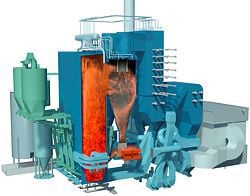Circulating fluidized bed (CFB) evolution from coal to biomass
Jan 16, 2018

The fuels used in CFBs have changed quite a lot over the last 30 years, from coal to petcoke, and later to biomass together with waste fractions. The trend recently has been multifuel design. Having three to five design fuels for the same boiler is quite normal today. This decreases the price and availability risk of fuels with a very small additional investment. Right now, most renewable incentives have disappeared from solid fuels, and at the same time coal is not favored; many governments are even targeting entirely fossil-free power production in the near future. What the right fuel will be in the future is unclear.
Coal is not going to disappear from the CFB fuel portfolio, but most likely it will go to a very large capacity with high efficiency, most likely more than 300 MWe scale and supercritical steam values.
On the biomass side, more and more demanding fuel qualities must be accepted. Wood-based biomass is not available everywhere, and where it is available, there is competition for it because it is a raw material for many industries. The biomass that will be burned in boilers will be residues which are not used anywhere else, such as wood-based residues like forest residue and stumps, agro residues such as straw, or oil palm residues like palm kernel shells or empty fruit bunches. This means the boiler must ready for high-alkali and -chlorine fuels with higher and higher steam temperatures.
The amount of waste will continue to increase. Big cities globally have to consider waste as a source of energy instead of only incinerating it. CFB technology will get its share of this as a high-efficiency waste-firing technology.
The biggest benefit of CFB technology is the fuel flexibility. Regardless of what the future fuel portfolio will be, CFB is already on its way toward it.
The white paper found HERE shows how CFB technology has adapted to market needs over the last thirty years, from high-ash coal to low-calorific-value biomass, and from petcoke with a high sulfur content to waste fuel with a high chlorine content. Boiler component design has followed customers' needs, and at the same time reliability has increased and the need for maintenance has decreased. Fuel qualities are becoming more demanding, while steam values are increasing. CFB technology has proven its capability to adapt to changing technical requirements.
For more information on CFB technology, contact your Valmet representative.